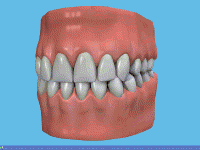 Sometimes bleeding gums (‘gingivitis’) tell us that we have areas which we missed when we brushed recently – when we brush better, the bleeding will stop with few permanent effects.
Sometimes bleeding gums (‘gingivitis’) tell us that we have areas which we missed when we brushed recently – when we brush better, the bleeding will stop with few permanent effects.
If this poor brushing continues it can cause what is known as gum disease – technically called ‘periodontitis’, (in the past it has been called ‘pyorrhoea’). This refers to the process where the pink gum and bone which holds a tooth secure begins to be damaged and disappears – leaving a loose tooth or teeth after years of slow progress.
It is routine for dentists to treat gum disease and this treatment usually involves repeated removal of the tartar around the tooth and under the gum, where it allows bacteria to fester and cause bone damage. As a patient you should also be informed that you have gum disease and often some improvement in your tooth brushing technique will be called for.
Toothbrushing should last for about 2 minutes each time to ensure maximum plaque removal and check no places are missed. However, because a normal toothbrush will only clean 65% of tooth surfaces, other aids like dental floss, tiny headed single tufted brushes and Interdental brushes should be used to get between the tight gaps in the teeth.
Smoking is a significant risk factor which makes gum disease much worse. Patients with gum disease are encouraged to stop.






